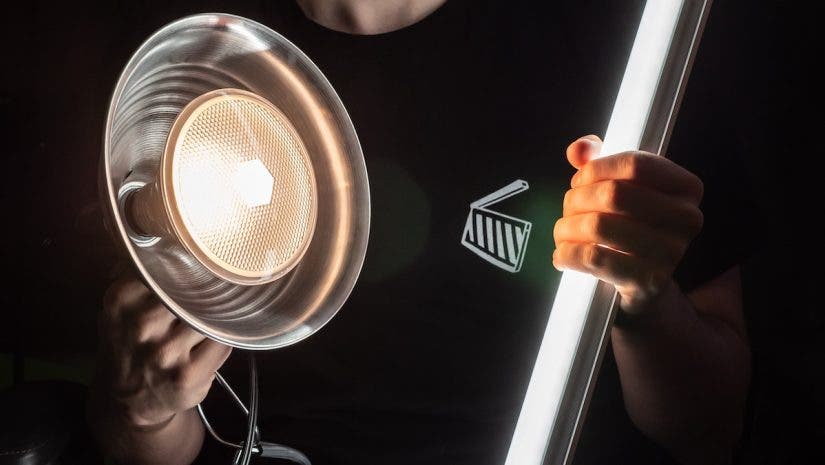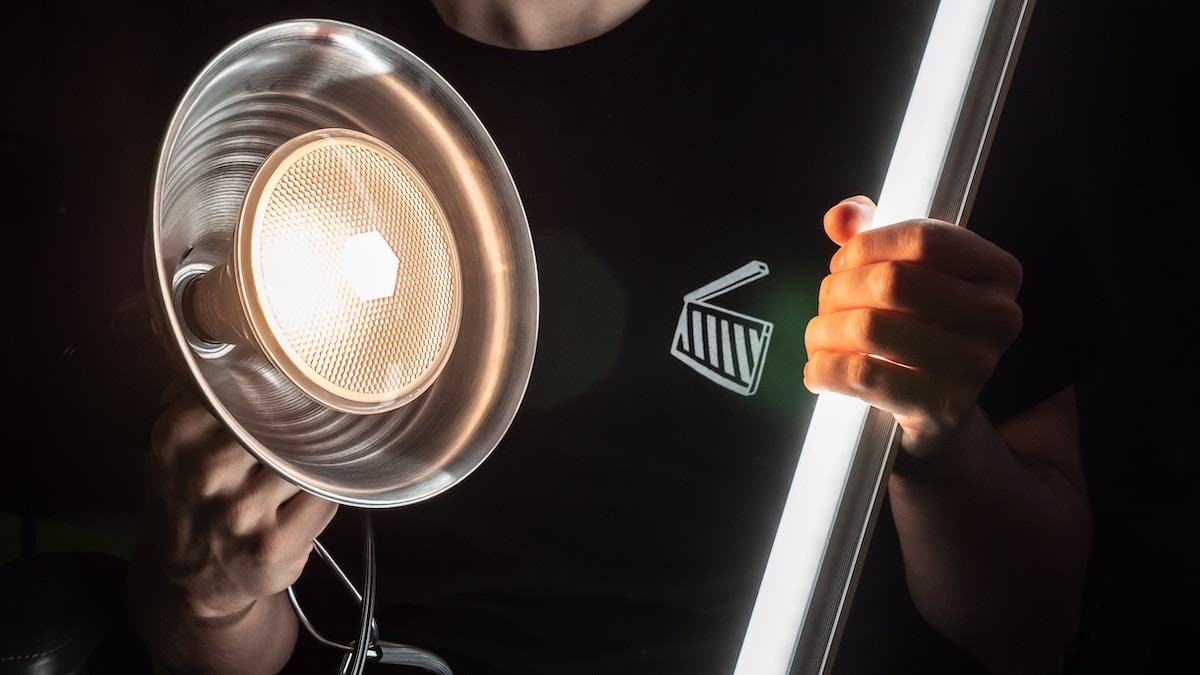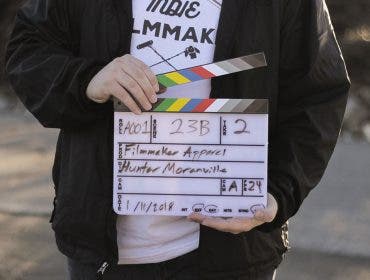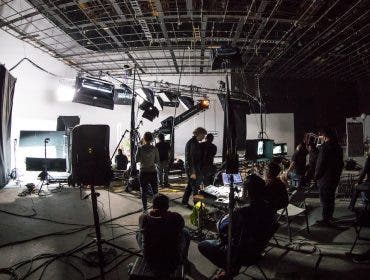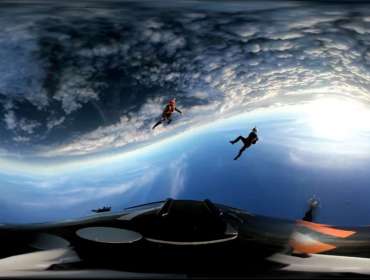When capturing film, there is no single thing more important than lighting. I work on film productions as a gaffer — also known as the Chief Lighting Technician — which means I am responsible for implementing the lighting on set at the direction of the cinematographer. I have worked with all kinds of lighting fixtures and units from all the manufacturers below. There are benefits to each type of film lights and I will give you an overview of them, including a list of popular fixtures that are often seen on film sets.
Types of Film Lights
Throughout history, there have been many different types of film lights. Below are some of the past and current technologies in film lighting, and their pros and cons.
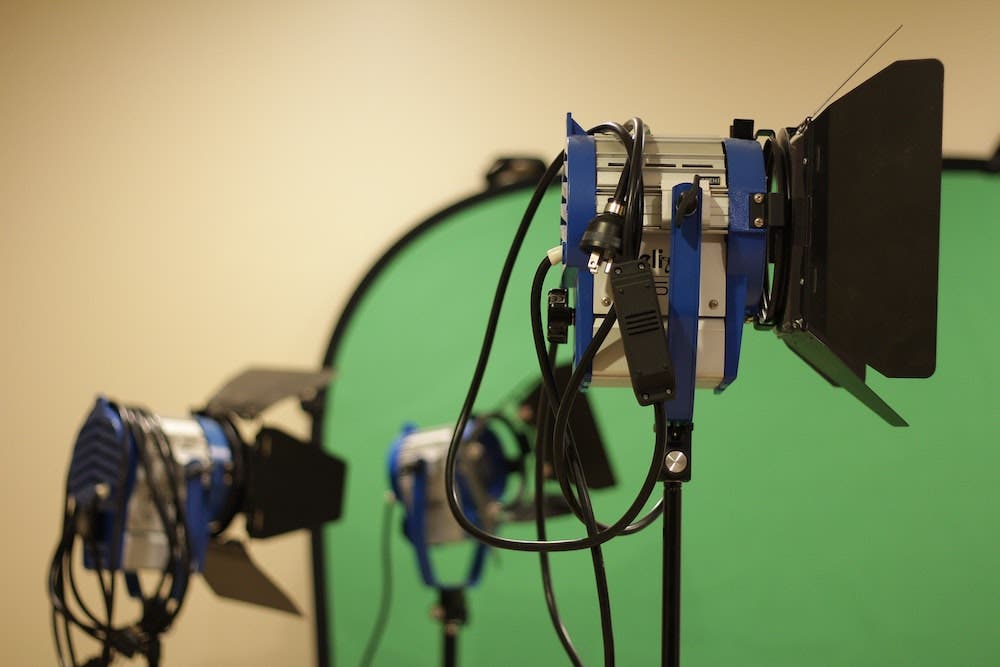
Tungsten Lights
One of the earliest and most common type of film lighting was tungsten lighting. Tungsten film lights are created by passing a current through a filament of tungsten. This heats up the filament until it glows, giving off visible light in the approximately 3200 Kelvin temperature range. For more information check out my article on color temperature. Tungsten gives you a very warm look that many cinematographers love. The color of the light is very pleasing when it is lighting skin tones. When dimming the light, the tungsten filament emits an orange hue that resembles firelight. While this is all great, the drawbacks of using tungsten film lights is its inefficiency. It takes a lot of power to get a greater light output. Tungsten also burns very hot, making the set feel like a sauna.
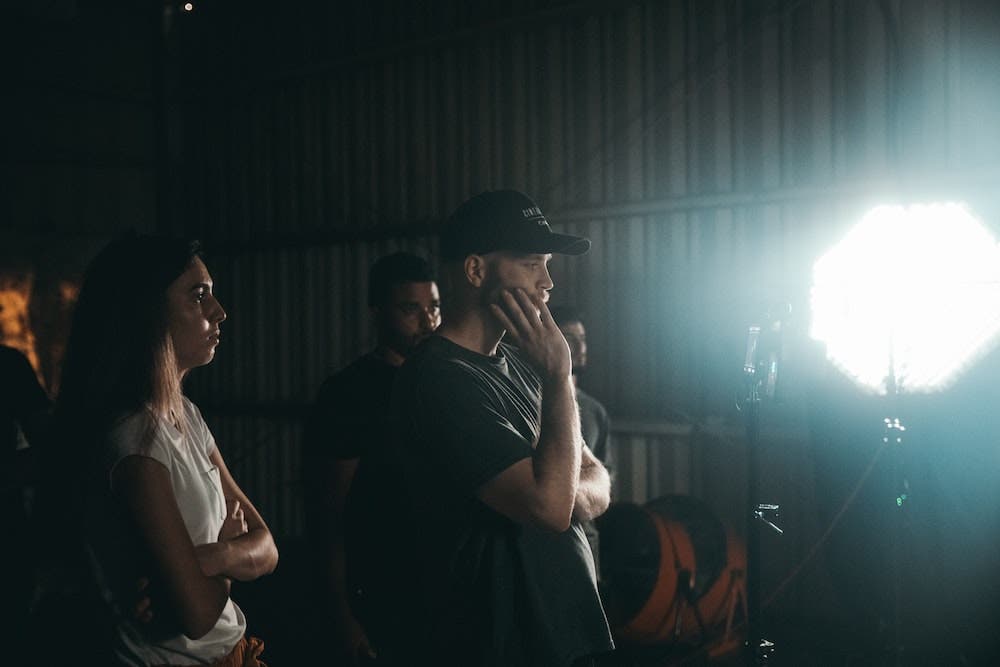
HMI Lights
HMI, or Hydrargyrum medium-arc iodide, operates by creating an arc of electricity between two electrodes which ignites mercury vapor. HMIs are more efficient than tungsten lights. They put out much more light for the same wattage, don’t put out nearly as much heat even at much higher light outputs, and — in terms of color temperature — are very close to the 5600 Kelvin color temperature of sunlight on a clear day. There are several manufacturers that put out HMI lights. Although, the M series from ARRI is by far the most well-known and most often seen on film sets.
The downsides of a HMI film light is that the bulbs are very expensive yet only marginally dimmable. They also take a minute or two to get fully warmed up to full brightness. To get the correct color temperature, you must wait a few minutes between when you turn an HMI off and when you want to turn it back on again. You can blow the bulb if you re-strike the light too quickly.

Fluorescent Lights
This is the naturally soft light that everyone knows from overhead office lighting or from supermarkets. The fluorescent tubed definitely gets a bad rap. Fluorescent lights are usually frosted tube lights. They work when the electrons get excited between the pins of the tube. This produces UV light which then hits the phosphor coating of the tube, emitting white light. The color temperature of these tubes can vary between 2700 Kelvin and 6500 Kelvin. This means you can have them closer to the tungsten end of the Kelvin scale or right around daylight. They are extremely energy-efficient, requiring very low power. They also output very soft light as they are in a tube format. This means there is a relatively large surface area for the light to escape.
The downsides for filmmakers are that they can flicker, depending on the quality of the light. The color quality of the bulbs can also vary, with a slight green cast being very common especially in older bulbs. There are, however, fluorescent tubes that are made specifically for film. These are more durable, have very good color rendition, and provide a decent amount of soft light.
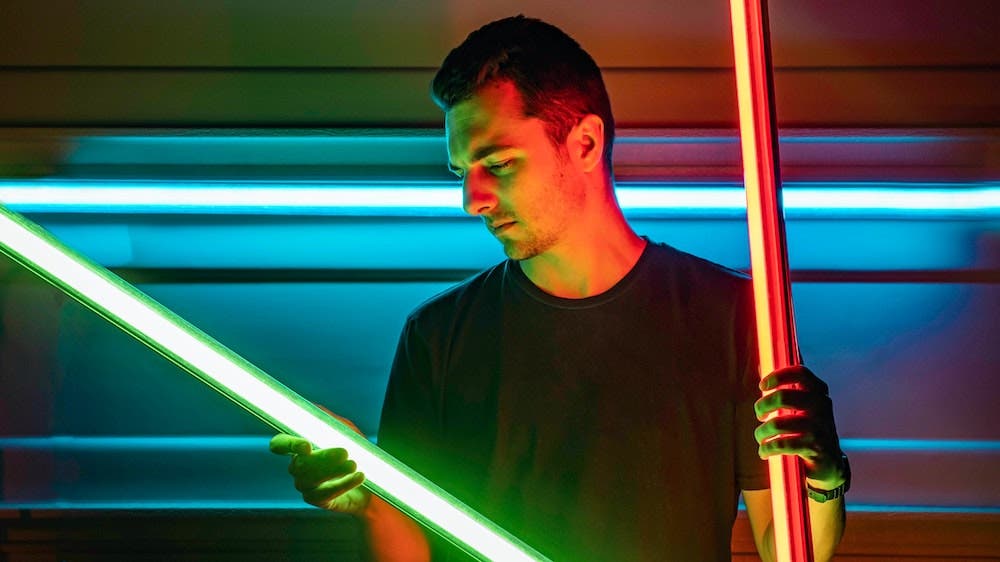
LED Lights
The latest innovation in lighting technology is LED lighting. LED stands for light emitting diode. It is basically a semi-conductor that can emit photons. LED lights are about 90 percent more efficient than incandescent light bulbs. With time, the color rendition of these lights has become excellent. The brightness is impressive (rivaling the HMIs that operate off of standard house power). Also, the price point is extremely affordable when compared to HMIs or larger tungsten fixtures. LED is definitely the future. The only downside I see is that this technology can’t reproduce the extremely bright lights needed for massive scenes.
Best Film Lights for Productions
Below you will find a range of different film lights — from the super high-end to products you can throw in your backpack. All of the lights I will discuss are LED lights.
Arri SkyPanel X21 Light Panel
This 800W RGBACL Modular LED Light Panel boasts native soft and native hard light capabilities, making it perfect for various lighting scenarios, from open-face setups for bouncing to modular configurations that suit your needs. Its IP66 all-weather rating ensures professional-grade durability and adaptability for any environment. With outstanding color rendition, dimming capabilities, and beam quality, the SkyPanel X21 truly excels. It provides a dynamic CCT range from 1,500K to 20,000K and features an RGBACL full-spectrum color engine, supported by 8 pixels. For the most efficient, brilliant, and uniform soft lighting directly over LEDs, the SkyPanel X21 stands as the go-to choice, and its interchangeability with modifiers further enhances its appeal.
ARRI Orbiter
The Arri Oribiter is the newest light from one of the pioneers in the film industry — ARRI. A German company that just celebrated their 100th year, ARRI has been and remains a major player in not only camera and lens technology, but also in film lighting. The Orbiter, uses a six-color light engine called Spectra. This mixing of six different colors leads to excellent color rendering across the whole of its CCT range. It also has a very wide color gamut for when you need to reproduce any color on the color wheel. The Orbiter also works with proprietary ARRI accessories. This will allow you to take this hard light and shape, soften, or spot it in exactly the way you want.
Arri SkyPanel S60-C LED Softlight
Another light from ARRI, the ARRI Skypanel S60-C, has been on almost every set I’ve been on for the past seven years. It still goes out on almost every job I work. This light is built to extremely rigorous standards. ARRI knew when they designed this light that it would see a lot of tough handling on film sets and this light has held up. When this light came out, it absolutely changed the game. The Skypanel outputs a soft, even light with a decent amount of pop, equivalent to a 2kW tungsten soft light. It is an RGBW light, has a CCT range of 2800K to 10,000K with adjustments of plus and minus green, and can reproduce several different effects. This light will continue to be used on film sets for some time.
Quasar Science Rainbow 2 25W Linear RGBX Quad LED Lighting Kit
Tube lights have been a staple of the film industry since even before KinoFlo made professional grade fluorescent tubes. The Rainbow 2 25W Linear RGBX Quad LED Lighting Kit 2’ tubes from Quasar Science use the same form factor as the tube lights you are used to, but add in RGB capabilities. This second version from Quasar Science have increased the pixel count and can deliver a choice of more than one billion colors. These lights also have robust mounting options, which has been an area that has been lacking in similar tubes from its competitors. These lights are also great to use as practical, in scene lights, especially in music videos. I have on many occasions had to rig up lots of tube lights in a scene with patterns that match the tone and tempo of the song.
Litepanels Gemini 2×1 Soft RGBWW LED Panel
Litepanels have made quite a splash with their own 2×1 soft panel. The Gemini 2×1 Soft RGBWW Panel has excellent color rendition. It is also relatively light for its size, meaning you can rig this light to a boom. It is flicker-free even at high shutter speeds or at lower intensities. I own the Gemini Soft 1×1 and I am extremely happy with it. I have often used the 2×1 on set. It is a robust and powerful light that I never hesitate to put on my gear list.
Rotolight NEO 3 On-Camera RGBWW LED 3-Light Kit
This is billed as the strongest LED on-camera light ever made. This light is not only great for filming, but also for photography as it works as a high speed RGB flash that has zero recycle time. You can keep on shooting without pausing. Getting the Rotolight NEO 3 On-Camera RGBWW LED 3-Light Kit gives you flexibility, as you can use two lights on your subject and one for the background. This is a very compact and powerful tool that is great for filmmakers as well as photographers.
Godox LED500LRW 3300K-5600K LED Video Light, White Version
An extremely affordable light, the Godox LED500LRW 3300K-5600K LED Video Light can be used on camera or off to help illuminate your subject when you are working in darker lighting conditions. This light is perfect for the camcorder operator who needs to get that little bit of extra light on the scene, but needs to keep their lighting budget-friendly.
Aputure Light Storm 600c Pro RGBWW LED Light
The recently released Aputure Light Storm 600c Pro is a very powerful, RGBWW point source light. This light is something I am seriously considering purchasing as it ticks a lot of the boxes I am looking for in an LED light. It works with many of the Aputure bowens mount accessories, such as the Light Dome II, F10 Fresnel, and most importantly for me, the Spotlight Mount. I love the combination of using this light and its RGB capabilities with a spotlight mount. This allows me to add pops of color without having to go through my gel collection. This is definitely a great light with a lot of power and versatility.
Aputure Nova P600c 600W 2×1 RGBWW LED Soft Light Panel Kit
Another light from Aputure, the Aputure Nova P600c, is a soft panel light that has amazing output, great pixel control, and 19 lighting effects. The front frosted panel is also removable when you need that extra little bit of light. The control box is also removable. You can tether it to the light using a cable when the light would be out of reach. This is a very affordable yet fully functional option for the person who is looking to purchase a panel light.
Godox SL-60 LED Video Light (Daylight-Balanced)
This is a very affordable 60 Watt daylight-balanced COB light, meaning it is a hard single point light. You can modify the Godox SL-60 LED Video Light (Daylight-Balanced) using the Bowens S-mount. This allows you to use a variety of different modifiers and accessories. The light features color accurate rendering and a decent output for its low 60 watt power draw.
Lume Cube 2.0 Professional Lighting Kit
The sign of a solid company is to take in the opinions of its users and use that feedback to make a product even better. This is exactly what Lumecube did with the second version of their teeny, tiny, but super powerful light. The Lume Cube 2.0 is a rugged, powerful, waterproof, daylight-balanced light. The battery life is about 1.5 hours at full power and comes with a diffusion panel, CTO warming gel, and a camera mount. This is the perfect travel light when you don’t know what light conditions you will be facing.
Lighting technology used to evolve very slowly. Although, with the advent of LED lighting, the world of lighting is rapidly changing. Lights are getting more versatile in terms of modification, color, and CCT options as well as lighter and brighter. This is an exciting time for film lights as it is democratizing lighting as the prices for bright lights keep coming down. This allows people who want to learn and play with film lighting the opportunity to do so.
